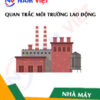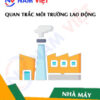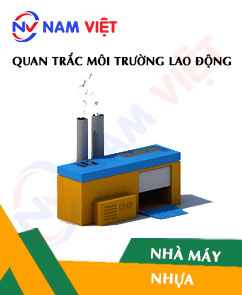Occupational Environment Monitoring at the Electronic Scale Manufacturing Factory
99,000 ₫
Note: The above price is calculated for one sample, and the price may fluctuate depending on the area of the environment to be monitored and market movements. For more accurate pricing support, please refer to the pricing table or contact our consulting staff directly.
Environmental monitoring of an electronic scale manufacturing factory is a session of collecting, analyzing, and evaluating workplace factors that may be harmful to workers’ health.
Table of Contents
Toggle1. Overview of Electronic Scale Manufacturing Factories
a. What is an Electronic Scale Manufacturing Factories?
An electronic scale manufacturing factory is a production facility specializing in the design, manufacture, and assembly of various types of electronic scale. Electronic scales are devices used to measure the mass or weight of an object by employing the operational principles of electronic sensors.

b. Production stages in an electronic scale manufacturing factories
In an electronic scale manufacturing factory, the typical production stages include:
- Design and research: Engineers and designers develop models and design blueprints for electronic scales.
- Procurement and material management: Ordering components and materials needed for production, including sensors, electronic parts, casings, and other components.
- Assembly and installation: Assembling components and electronic parts into the basic frame of the electronic scale, then installing additional parts such as displays, keypads, control buttons, and connectivity devices.
- Inspection and calibration: Conducting testing and calibration of electronic scales to ensure accuracy and reliability. Testing procedures may include weight measurement and functional checks.
- Packing and shipping: Completing production by packing electronic scales according to standards and preparing them for delivery to retail outlets or end customers.

c. Machinery used in electronic scale manufacturing factories
In electronic scale manufacturing factories, several types of machinery and equipment are used throughout the production process. Examples of commonly used machinery include:
- Steel cutting and bending machines: Used to cut and bend metal components, such as steel, to create frames and basic parts of electronic scales.
- Casing cutting and processing machines: Used to cut and process plastic, aluminum, or steel panels to produce electronic scale casings.
- Welding and assembly machines: Used to weld and assemble parts and components of electronic scales to form the finished product.
- Printing and labeling machines: Used to print and label information related to electronic scales, including labels, barcodes, technical specifications, and user instructions.
- Testing and calibration machines: Used to inspect and calibrate electronic scales to ensure accuracy and reliability, including precision measurement devices and calibration equipment.
- Packing and boxing machines: Used to package electronic scales into smaller units and box them for shipping preparation.
- Quality control machines: Used to verify the quality of electronic scales after production, including functional testing, accuracy checks, and other evaluations.

d. Occupational diseases that workers in electronic scale manufacturing factories may encounter
Workers in electronic scale manufacturing factories may be exposed to certain occupational diseases related to their working environment and tasks. Common occupational diseases in electronic scale production include:
- Respiratory diseases: Workers may be exposed to metal dust, chemicals, or fumes from cutting, welding, or machining metal components, leading to pneumonia, asthma, and other respiratory problems.
- Skin diseases: Prolonged exposure to chemicals during production may cause skin irritation, dermatitis, eczema, and other skin conditions.
- Noise-related diseases: Machinery and equipment can generate high levels of noise. Continuous exposure may cause hearing loss, insomnia, stress, and mental health issues.
- Posture-related and musculoskeletal injuries: Some tasks may require prolonged unnatural postures or heavy physical exertion, leading to back pain, neck pain, joint inflammation, and other musculoskeletal injuries.
- Psychological stress: Work pressure and production processes may cause psychological stress and mental health issues such as anxiety, depression, and tension.
To protect workers’ health, safety and occupational protection measures must be implemented in electronic scale manufacturing factory, including maintaining workplace hygiene, providing personal protective equipment guidance, reducing noise, and other measures to minimize exposure to harmful factors and reduce psychological stress.

e. Common types of electronic scales on the market
There are many common types of electronic scales serving different purposes and applications, including:
- Personal electronic scales: Used in homes and gyms to measure individual body weight.
- Kitchen electronic scales: Used in kitchens for precise measurement of ingredients in cooking and baking.
- Industrial electronic scales: Commonly used in industrial settings, factories, and warehouses to weigh materials, goods, and containers.
- Laboratory electronic scales: Used in laboratories for precise measurement of samples, chemicals, and solutions.
- Medical electronic scales: Used in healthcare facilities to weigh patients and measure pharmaceuticals.
- Truck electronic scales: Used to weigh trucks, containers, and cargo transport vehicles.
- Packaging electronic scales: Used in the packaging industry to weigh goods, ensuring order accuracy and consistency.
- Counter electronic scales: Used in stores and supermarkets to weigh products and calculate payment amounts.
2. Overview of Occupational Environment Monitoring Services
a. What is occupational environment monitoring in electronic scale manufacturing factories?
Occupational environment monitoring (or workplace environment measurement) in electronic scale manufacturing factories involves collecting, evaluating, and analyzing measurements of workplace environmental factors to implement timely interventions, minimize environmental health hazards, and prevent occupational diseases. Monitoring the workplace environment is mandatory for electronic scale manufacturing factory.
Occupational environment monitoring plays a critical role in protecting and enhancing worker health because employees are the primary resource of enterprises and directly generate profit. Workers frequently exposed to risks or harmful factors above permissible limits may suffer health problems and occupational diseases.
REGISTER FOR OCCUPATIONAL ENVIRONMENT MONITORING SERVICE
b. Nam Viet’s occupational environment monitoring program
Nam Viet’s occupational environment monitoring program is developed by engineers specializing in occupational safety and environmental protection. Aiming to ensure worker health and safety, the program uses modern measurement methods to monitor air quality, water, and microclimate, physical factors, dust, and more in the workplace. This program is essential for ensuring a safe working environment and protecting workers’ health.
Additionally, Nam Viet’s program plays an important role in researching and developing solutions to improve workplace environmental quality. With the dedication and professionalism of its monitoring experts, Nam Viet’s proprietary program is a breakthrough in labor safety management and environmental protection in Vietnam.

c. Standardization in workplace measurement procedures
Standardization in Nam Viet’s workplace measurement procedures is crucial to ensure the quality of results. To guarantee accuracy and reliability, the program applies recognized standards and procedures from the Ho Chi Minh City Department of Health. This ensures that collected data is highly reliable for evaluating workplace environments and making decisions to improve worker health and safety.
These standardized procedures also ensure that measurements are conducted by highly skilled monitoring specialists with years of experience, enabling managers and experts to trust Nam Viet’s results and make accurate, valuable decisions for worker and environmental protection.
By applying standardization in workplace monitoring, Nam Viet demonstrates its commitment to a safe working environment and health protection, while contributing to improved labor safety and environmental management in Vietnam.
d. Reporting occupational environment monitoring results in electronic scale manufacturing factories
Monitoring results are compiled according to Form No. 04, Appendix III of Decree 44/2016/ND-CP and prepared in two copies: one sent to the production facility that contracted the monitoring service, and one retained by the monitoring organization.
According to legal regulations, monitoring records must be stored indefinitely.

e. Frequency of workplace environment monitoring according to the law
According to Clause 2, Article 18 of the Labor Safety and Hygiene Law 84/2015/QH13, employers must organize workplace environment monitoring to assess harmful factors at least once per year.
f. Deadline for submitting occupational environment monitoring reports according to the law
The deadline for submission is before December 31 each year. Enterprises must submit occupational environment monitoring reports to the local Department of Health where their main office is located and where employees are working.
When changes occur in technology, production processes, or upgrades that may introduce new harmful factors, enterprises must update their occupational hygiene records with content related to the harmful factors that need monitoring.
g. Penalties for violations of occupational environment monitoring by employers
According to Article 27 of Decree 12/2022/ND-CP dated January 17, 2022, regulating administrative penalties in labor, social insurance, and Vietnamese workers working abroad under contracts:
- Clause 2: A fine of 2,000,000 – 5,000,000 VND for employers who fail to publicly disclose to workers at the monitoring site and relevant areas the results of occupational environment monitoring and risk assessments immediately after the results are available.
- Clause 3: A fine of 20,000,000 – 40,000,000 VND for employers who do not conduct occupational environment monitoring to control health hazards as required by law.
- Clause 4: A fine of 40,000,000 – 60,000,000 VND for employers who collude with monitoring organizations to commit fraud in workplace environment monitoring, without reaching criminal liability.
3. Harmful Environmental Factors for Workers in Electronic Scale Manufacturing Factories
Some harmful environmental factors may exist in an electronic scale manufacturing factory and can affect the health of workers. The main factors include:
- Dust and particles: The production process of electronic scales can generate dust and small particles from materials such as metals, plastics, rubber, and chemical compounds. Inhaling these dusts and particles can cause respiratory irritation, pneumonia, or harm the respiratory system of workers.
- Chemicals: During electronic scale production, chemicals such as solvents, cleaning agents, preservatives, and sealants may be used. Exposure to these chemicals can irritate the skin, eyes, and respiratory system, or potentially harm internal organs.
- Noise: Machinery and equipment in electronic scale manufacturing factories may produce high levels of noise, especially during operation. Continuous and excessive noise can cause stress, insomnia, and affect workers’ hearing.
- Lighting: The working environment in electronic scale manufacturing factories may involve strong or artificial lighting. Continuous exposure to intense or inappropriate lighting can lead to eye fatigue, eye strain, and affect workers’ vision.
- Temperature and humidity: Some processes in electronic scale production may require specific temperature and humidity conditions. Inappropriate working conditions can cause fatigue, discomfort, and impact workers’ health and performance.
REGISTER FOR WORKPLACE ENVIRONMENT MONITORING SERVICE
4. Measures to Improve the Working Environment in Electronic Scale Manufacturing Factories
To improve the working environment in electronic scale manufacturing factory and protect workers’ health, the following measures can be applied:
- Dust and particle management: Ensure that dust extraction systems are functioning properly to reduce dust and particles in the air. Additionally, provide protective equipment such as masks and safety glasses to prevent direct exposure to dust and particles.
- Chemical management: Use safe and appropriate chemicals during production. Ensure that workers are trained in safe handling and protective measures when working with chemicals. Provide personal protective equipment such as gloves, protective clothing, and goggles to protect skin and eyes from direct contact with chemicals.
- Noise management: Install soundproofing and insulation measures to reduce noise from machinery and equipment. Provide protective earplugs or earmuffs for workers in high-noise environments.
- Lighting management: Ensure sufficient natural lighting and appropriate artificial lighting in the work area. Use lamps with suitable color and intensity to prevent eye fatigue for workers.
- Temperature and humidity adjustment: Ensure that the working environment maintains ideal temperature and humidity levels. Use air conditioning and humidity control systems to create a comfortable and healthy working environment.
- Training and education: Provide training and education for workers on occupational safety, safe work procedures, use of protective equipment, and environmental hazard prevention measures. Ensure that workers understand and comply with safety regulations and work protocols.
- Periodically conduct workplace environment monitoring in factories, collect and analyze harmful factors for workers, and make adjustments to reduce hazards, thereby preventing occupational diseases.
5. Benefits of Regular Monitoring in Electronic Scale Manufacturing Factories
An Toan Nam Viet provides businesses with excellent benefits when using workplace environment monitoring services in accordance with Decree 44/2016/ND-CP on managing and controlling harmful factors in the working environment affecting employees.
- Businesses can proactively control harmful factors in their workshops or factories.
- Receive recommendations for measures to reduce harmful factors and improve the quality of the working environment.
- Indirectly protect human resources, the key factor in business development.
- Minimize the health impact of occupational diseases, reducing future medical treatment costs.
- Enhance workers’ health, which leads to better product quality and maintained production output.
- Ensure compliance with occupational safety laws, avoiding legal risks.
- Build credibility and professionalism in all aspects, thereby enhancing the company’s brand image.
Nam Viet’s environmental monitoring service is a solution to minimize the effects of occupational diseases, contributing to a clean and quality working environment.

6. Nationwide Workplace Environment Monitoring Center
Nam Viet Workplace Environment Monitoring Center is a professional unit specializing in supervising and measuring workplace environmental quality across all provinces of Vietnam. With a team of experienced monitoring specialists, the center uses modern measurement equipment to ensure accuracy and reliability.
In addition to providing monitoring services, the center supports clients in planning, handling, and tracking workplace environmental issues. With the motto “customer-centric,” the center focuses on customer satisfaction, meeting all needs, and committing to providing the best solutions for businesses.
REGISTER FOR WORKPLACE ENVIRONMENT MONITORING SERVICE
With investments in technology, equipment, and human resources, Nam Viet’s monitoring center has become a reputable unit in workplace environmental monitoring in Ho Chi Minh City with the following goals:
- We always value our brand reputation and the quality of our services.
- We provide customers with the best and most suitable solutions.
- Along with a team of experienced Masters and Engineers dedicated to environmental protection and benefiting businesses.
- By partnering with Nam Viet Environmental Monitoring team, companies receive professional service from experts in the field, as well as the best cost advantages.
The workplace environment monitoring process at Nam Viet includes the following basic steps:
- Before conducting monitoring, we ensure all equipment is calibrated and adjusted according to legal requirements.
- Follow the complete workplace environment monitoring procedures as committed to the Department of Health.
- Report monitoring results truthfully to the employer.
- If monitoring results show unsafe conditions for workers, Nam Viet will assist in providing solutions, and the workplace will implement:
- Implement measures to improve working conditions to minimize harmful factors and prevent occupational diseases.
- Organize health examinations to detect occupational and related diseases early for workers in hazardous positions.
- Provide in-kind compensation to workers according to labor law.

7. Workplace Environment Monitoring Price List
To help businesses conduct professional and effective workplace environment monitoring, Nam Viet provides customers with a price list of workplace environment monitoring services with high quality and reasonable costs.
- Our price list provides detailed information about the costs of the monitoring services offered, including travel, measurement, analysis, and reporting. Customers can rely on the accuracy and reliability of our monitoring reports.
- We commit to offering the most competitive and reasonable prices on the market, and we are always ready to provide quick and professional consultation for any questions regarding monitoring services.
- With Nam Viet’s price list, customers can easily select service packages that match their needs. We guarantee the highest satisfaction with professional service quality.
No comments yet












Review Occupational Environment Monitoring at the Electronic Scale Manufacturing Factory
There are no reviews yet.